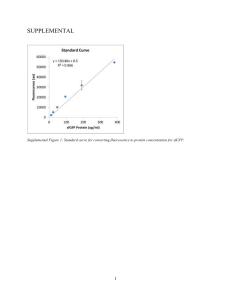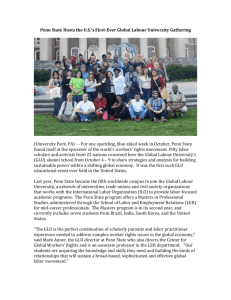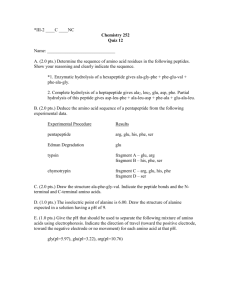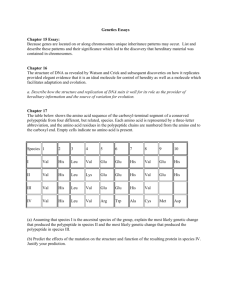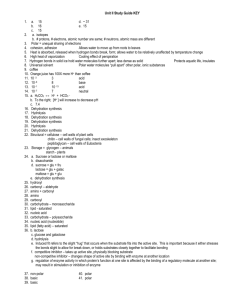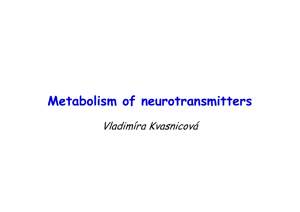Inversion Formulas rm ?
advertisement
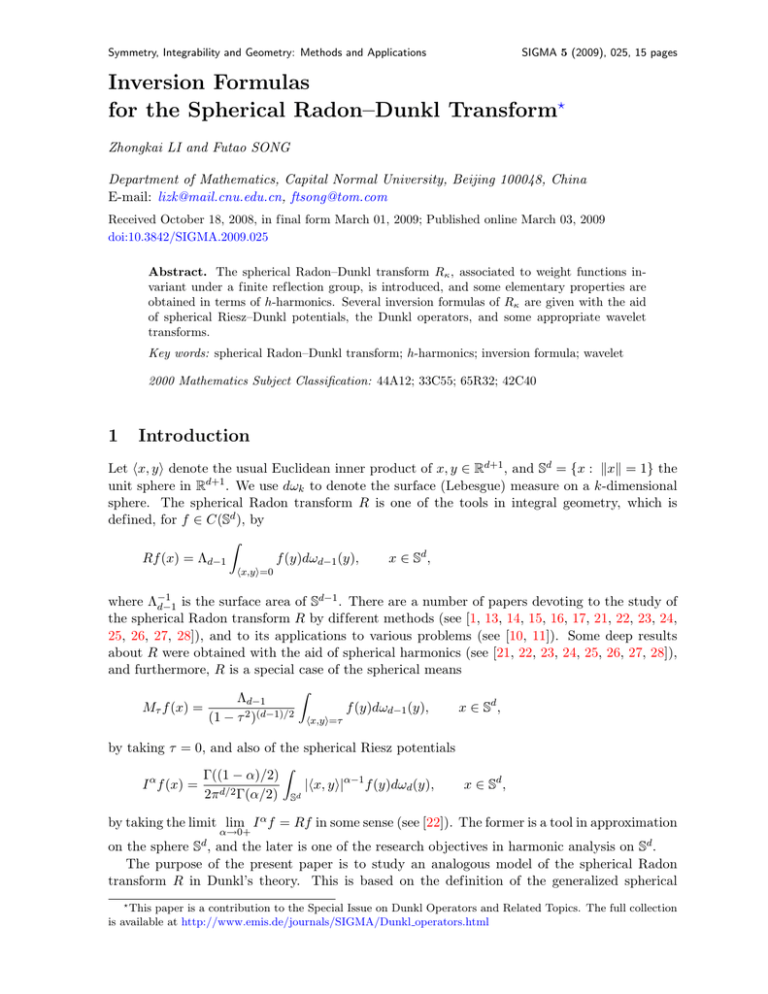
Symmetry, Integrability and Geometry: Methods and Applications
SIGMA 5 (2009), 025, 15 pages
Inversion Formulas
for the Spherical Radon–Dunkl Transform?
Zhongkai LI and Futao SONG
Department of Mathematics, Capital Normal University, Beijing 100048, China
E-mail: lizk@mail.cnu.edu.cn, ftsong@tom.com
Received October 18, 2008, in final form March 01, 2009; Published online March 03, 2009
doi:10.3842/SIGMA.2009.025
Abstract. The spherical Radon–Dunkl transform Rκ , associated to weight functions invariant under a finite reflection group, is introduced, and some elementary properties are
obtained in terms of h-harmonics. Several inversion formulas of Rκ are given with the aid
of spherical Riesz–Dunkl potentials, the Dunkl operators, and some appropriate wavelet
transforms.
Key words: spherical Radon–Dunkl transform; h-harmonics; inversion formula; wavelet
2000 Mathematics Subject Classification: 44A12; 33C55; 65R32; 42C40
1
Introduction
Let hx, yi denote the usual Euclidean inner product of x, y ∈ Rd+1 , and Sd = {x : kxk = 1} the
unit sphere in Rd+1 . We use dωk to denote the surface (Lebesgue) measure on a k-dimensional
sphere. The spherical Radon transform R is one of the tools in integral geometry, which is
defined, for f ∈ C(Sd ), by
Z
Rf (x) = Λd−1
f (y)dωd−1 (y),
x ∈ Sd ,
hx,yi=0
−1
is the surface area of Sd−1 . There are a number of papers devoting to the study of
where Λd−1
the spherical Radon transform R by different methods (see [1, 13, 14, 15, 16, 17, 21, 22, 23, 24,
25, 26, 27, 28]), and to its applications to various problems (see [10, 11]). Some deep results
about R were obtained with the aid of spherical harmonics (see [21, 22, 23, 24, 25, 26, 27, 28]),
and furthermore, R is a special case of the spherical means
Z
Λd−1
Mτ f (x) =
f (y)dωd−1 (y),
x ∈ Sd ,
(1 − τ 2 )(d−1)/2 hx,yi=τ
by taking τ = 0, and also of the spherical Riesz potentials
Z
Γ((1 − α)/2)
α
I f (x) =
|hx, yi|α−1 f (y)dωd (y),
x ∈ Sd ,
2π d/2 Γ(α/2) Sd
by taking the limit lim I α f = Rf in some sense (see [22]). The former is a tool in approximation
α→0+
on the sphere Sd , and the later is one of the research objectives in harmonic analysis on Sd .
The purpose of the present paper is to study an analogous model of the spherical Radon
transform R in Dunkl’s theory. This is based on the definition of the generalized spherical
?
This paper is a contribution to the Special Issue on Dunkl Operators and Related Topics. The full collection
is available at http://www.emis.de/journals/SIGMA/Dunkl operators.html
2
Zh.-K. Li and F.-T. Song
means Mτκ f (x) due to [33] (instead of Mτκ , the notation Tθκ with τ = cos θ was used there), in
terms of the equation
Z
Z 1
κ
f (y)Vκ [g(hx, ·i)](y)h2κ (y)dωd (y)
Mτ f (x)g(τ )wλκ (τ )dτ = cκ
Sd
−1
for any g in L1 ([−1, 1]; wλκ ), where wλκ (t) = c̃λκ +1/2 (1 − t2 )λκ −1/2 , Vκ is the intertwining operator associated to a given finite reflection group, and h2κ is the related weight function (for details
concerning them and other notations in the equation, see the next section). We define Rκ by
Rκ f = M0κ f , and call Rκ the spherical Radon–Dunkl transform. Although Mτκ is defined implicitly, it is a proper extension of Mτ and Mτ0 = Mτ , and moreover, from [2] and [33, 34, 35, 36],
Mτκ shares many properties with Mτ and plays the same roles in weighted approximation and
related harmonic analysis on the sphere Sd . One could expect that the spherical Radon–Dunkl
Transform Rκ would have similar features to R and be a suitable tool in reconstruction of functions in weighted spaces. This is the motivation of the paper. Despite less closed representation,
a further work worth doing is to find applications of Rκ in geometry or other fields.
The paper is organized as follows. In Section 2, some necessary facts in Dunkl’s theory are
reviewed, and in Section 3, the spherical Radon–Dunkl transform Rκ is defined and some of
elementary properties are obtained in terms of h-harmonics. Sections 4 and 5 are devoted to
inversion formulas of Rκ , which are given by means of spherical Riesz–Dunkl potentials Iκα , the
Dunkl operators, and some appropriate wavelet transforms. These conclusions generalize part
of those in [21, 22, 23].
2
Some facts in Dunkl’s theory
Let G be a finite reflection group on Rd+1 with a fixed positive root system R+ , normalized so
that hv, vi = 2 for all v ∈ R+ . It is known that G is a subgroup of O(d + 1) generated by {σv :
v ∈ R+ }, where σv denotes the reflection with respect to the hyperplane perpendicular to v,
i.e. xσv = x − 2(hx, vi/hv, vi)v for x ∈ Rd+1 . Let κ be a multiplicity function v 7→ κv ∈ [0, +∞)
defined on R+ , with invariance under the action of G. Thus {κv : v ∈ R+ } has different values
only as many as the number of G-orbits in R+ .
The Dunkl operators are a family of first-order differential-reflection operators Dj , 1 ≤ j ≤
d + 1, defined by (see [5])
X
f (x) − f (xσv )
hv, ej i,
Dj f (x) := ∂j f (x) +
κv
hx, vi
v∈R+
for f ∈ C 1 (Rd+1 ), where {ei : 1 ≤ i ≤ d+1} is the usual standard basis of Rd+1 . As substitutes of
partial differentiations ∂j , these operators are mutually commutative. The associated Laplacian,
2 , which plays roles similar to that of the
called h-Laplacian, is defined by ∆h = D12 + · · · + Dd+1
usual Laplacian ∆ = ∆0 (see [4]). In terms of the polarspherical coordinates x = rx0 , r = kxk,
the operator ∆h can be expressed as (see [33])
∆h =
∂2
2λκ + 1 ∂
1
+ 2 ∆h,0 ,
+
2
∂r
r
∂r r
where P
∆h,0 is the associated Laplace-Beltrami operator on Sd , and λκ = γκ + (d − 1)/2 with
γκ =
κv . If γκ = 0, i.e. κv ≡ 0, then Dj = ∂j , 1 ≤ j ≤ d + 1. In the following, we assume
v∈R+
that γκ > 0, and so λκ > 0.
For each multiplicity function κ, there is a linear operator Vκ intertwining the partial differentiations and the Dunkl operators (see [6]). Precisely, if Pn = Pnd+1 denotes the set of homogeneous polynomials of degree n in d + 1 variables, then the intertwining operator Vκ is determined
Inversion Formulas for the Spherical Radon–Dunkl Transform
3
uniquely by Vκ Pn ⊆ Pn , Vκ 1 = 1 and Dj Vκ = Vκ ∂j , 1 ≤ i ≤ d + 1. Vκ commutes with the
group action and is a linear isomorphism on each Pn (n = 0, 1, . . . ). Moreover it is a positive
operator (see [18]) and can be extended to the space of smooth functions and even to the space
of distributions (see [29, 30]).
The intertwining operator Vκ allows to introduce some useful tools in Dunkl’s theory. For
example, the Dunkl transform Fκ is defined in [7] associated with the measure h2κ dx on Rd+1 ,
where
Y
hκ (x) =
|hx, vi|κv .
v∈R+
Fκ is a generalization of the Fourier transform F = F0 and enjoys properties similar to those
of F (see [3, 7, 19]).
R
1/p
For 1 ≤ p < ∞, denote by kf kκ,p = cκ Sd |f |p h2κ dωd
the norm of f ∈ Lp (Sd ; h2κ ), with
n
o
1/p
R
R1
2
p
the norm of φ ∈ Lp ([−1, 1], wλκ ), where
c−1
κ = Sd hκ dωd , and by kφkλκ ,p =
−1 |φ| wλκ dt
wλκ (t) = c̃λκ +1/2 (1 − t2 )λκ −1/2 , c̃λ = π −1/2 Γ(λ + 1/2)/Γ(λ). When p = ∞, kf k∞ = kf kκ,∞ and
kφk∞ = kφkκ,∞ are defined as usual.
The functions in Hnh,d+1 := Pnd+1 ∩ ker ∆h are called h-harmonic polynomials of degree n, and
the spherical h-harmonics of degree n are their restrictions on Sd . The orthogonality theorem
R
n−1
in [4] asserts that if P ∈ Pnd+1 , then Sd P Qh2κ dωd = 0 for all Q ∈ ∪ Pkd+1 , if and only if P is
k=0
∞ L
P
h,d+1
2
d
2
h-harmonic, i.e. ∆h P = 0. Moreover L (S ; hκ ) =
Hn
.
n=0
If Yn (h2κ ; f ; x) is the projection of f ∈ L1 (Sd ; h2κ ) to Hnh,d+1 , then the h-harmonic expansion
of f is given by
f (x) ∼
∞
X
Yn h2κ ; f ; x ,
x ∈ Sd .
(1)
n=0
The projection Yn (h2κ ; f ; x) takes the form
Z
2
Yn (hκ ; f ; x) = cκ
f (y)Pn h2κ ; x, y h2κ (y)dωd (y),
(2)
Sd
where Pn (h2κ ; x, y) is the reproducing kernel of the space Hnh,d+1. A compact formula of Pn (h2κ ; x, y)
is (see [32])
Pn (h2κ ; x, y) =
n + λκ λκ
Vκ Cn (hx, ·i) (y),
λκ
(3)
with Cnλκ , the Gegenbauer polynomial of degree n with parameter λκ . It is noted that (see [33])
∆h,0 Yn = −n(n + 2λκ )Yn ,
Yn ∈ Hnh,d+1 .
(4)
When κv = 0 for all v ∈ R+ , we have V0 = id, and hence, Pn (h2κ ; x, y) reduces to the usual
(d−1)/2
zonal polynomial for the ordinary spherical harmonics Pn (x, y) = n+(d−1)/2
(hx, yi).
(d−1)/2 Cn
A useful integration formula for the intertwining operator Vκ is
Z
Z
γ −1
c−1 Γ(λκ + 1)
Vκ f (x)h2κ (x)dωd (x) = κ(d+1)/2
f (x) 1 − |x|2 κ dx.
(5)
π
Γ(γκ ) Bd+1
Sd
The formula is proved in [31] when f is a polynomial. Applying density of polynomials and
positivity of Vκ , this allows us to extend the intertwining operator Vκ acting on those functions f
4
Zh.-K. Li and F.-T. Song
on the sphere Sd which are restrictions of functions in L1 (Bd+1 ; (1 − |x|2 )γκ −1 ), and moreover,
the formula (5) is true for these functions too and Vκ f ∈ L1 (Sd ; h2κ ). In particular, if φ ∈
L1 ([−1, 1]; wλκ ), then for each y ∈ Sd ,
Z
φ(hx, yi) 1 − |x|2
γκ −1
dx =
Bd+1
π (d+1)/2 Γ(γκ )
Γ(λκ + 1)
Z
1
−1
φ(t)wλκ (t)dt,
(6)
i.e. f (x) = φ(hx, yi) ∈ L1 (Bd+1 ; (1 − |x|2 )γκ −1 ), and hence Vκ [φ(h·, yi)] is well defined and in
L1 (Sd ; h2κ ). In addition, we have the following symmetric relation
Vκ [φ(h·, yi)](x) = Vκ [φ(hx, ·i)](y),
for a.e.
(x, y) ∈ Sd × Sd .
(7)
The validity of (7) for polynomials and for all (x, y) ∈ Sd ×Sd follows from Gegenbauer expansions
and the symmetry of the reproducing kernels Pn (h2κ ; x, y), If φ ∈ L1 ([−1, 1]; wλκ ) and φ1 is
a univariate polynomial, then applying (5) and (6),
Z Z
|Vκ [φ(h·, yi)](x) − Vκ [φ(hx, ·i)](y)|h2κ (x)h2κ (y)dωd (x)dωd (y)
d
d
S
S Z Z
=
|Vκ [(φ − φ1 )(h·, yi)](x) − Vκ [(φ − φ1 )(hx, ·i)](y)|h2κ (x)h2κ (y)dωd (x)dωd (y)
d
d
S
S
Z 1
−2
≤ 2cκ
|φ(t) − φ1 (t)|wλκ (t)dt,
−1
which implies (7) by the density of polynomials in L1 ([−1, 1]; wλκ ). Following the above remarks,
the Funk–Hecke formula for h-harmonics proved in [32] (for continuous functions there only)
holds also for φ ∈ L1 ([−1, 1]; wλκ ), that is
Z
cκ
Vκ [φ(h·, yi)](x)Hn (x)h2κ (x)dωd (x) = Ln (φ)Hn (y)
(8)
Sd
for each Hn ∈ Hnh,d+1 and y ∈ Sd , where
Z 1
C λκ (t)
Ln (φ) =
φ(t) nλκ wλκ (t)dt.
Cn (1)
−1
(9)
The convolution f ∗κ φ of two functions f ∈ L1 (Sd ; h2κ ) and φ ∈ L1 ([−1, 1]; wλκ ) is defined
in [34], by
Z
f ∗κ φ(x) = cκ
f (y)Vκ [φ(hx, ·i)](y)h2κ (y)dωd (y).
(10)
Sd
The Young inequality concerning such convolution is proved in [34], that is, for p, q, r ≥ 1 with
r−1 = p−1 + q −1 − 1,
kf ∗κ φkκ,r ≤ kf kκ,p kφkλκ ,q .
(11)
A typical example of Dunkl’s theory is the case when G = Z2d+1 , for which, the function hκ (x)
has the form hκ (x) = |x1 |κ1 · · · |xd+1 |κd+1 and the intertwining operator Vκ is given by
Z
f (x1 t1 , . . . , xd+1 td+1 )
Vκ f (x) = c̃κ
[−1,1]d+1
where c̃κ = c̃κ1 · · · c̃κd+1 .
d+1
Y
i=1
(1 + ti )(1 − t2i )κi −1 dt1 · · · dtd+1 ,
(12)
Inversion Formulas for the Spherical Radon–Dunkl Transform
3
5
The spherical Radon–Dunkl transform
For f ∈ L1 (Sd ; h2κ ), its generalized spherical means Mτκ f (x) due to [33] is defined by the equation
Z 1
Mτκ f (x)φ(τ )wλκ (τ )dτ = f ∗κ φ(x)
(13)
−1
for any φ in L1 ([−1, 1]; wλκ ). Since, for φ ∈ L∞ (Sd ),
Z 1
κ
≤ kf kκ,1 kφk∞ ,
M
f
(x)φ(τ
)w
(τ
)dτ
λ
τ
κ
−1
it follows that, for each x ∈ Sd , the function ψx (τ ) = Mτκ f (x) ∈ L1 ([−1, 1]; wλκ ). This shows that
for almost all τ ∈ [−1, 1], Mτκ f is well defined. To give further illustration of Mτκ , we introduce
p
p
the space Wm
(Sd ; h2κ )(⊆ Lp (Sd ; h2κ )) of functions for m ≥ 0, such that for f ∈ Wm
(Sd ; h2κ ),
p
d
2
2
2
m/2
there exist some g ∈ L (S ; hκ ) satisfying Y0 (hκ ; f ) = Y0 (hκ ; g) and [n(n + 2λκ )]
Yn (h2κ ; f ) =
Yn (h2κ ; g) for all n = 1, 2, . . . . In view of (4), we formally write g = (−∆h,0 )m/2 f . It is noted
p
that for even m, C m (Sd ) ⊆ Wm
(Sd ; h2κ ) (1 ≤ p ≤ ∞). The following properties of Mτκ are proved
in [33, 34].
Proposition 1.
(i) If f0 (x) ≡ 1, then Mτκ f0 (x) ≡ 1.
(ii) For each τ ∈ [−1, 1], there is an extension of Mτκ to Lp (Sd ; h2κ ) (1 ≤ p < ∞), or C(Sd )
(p = ∞), such that
kMτκ f kκ,p ≤ kf kκ,p ,
τ ∈ [−1, 1].
(iii) For f ∈ L1 (Sd ; h2κ ),
Yn (h2κ ; Mτκ f ; x) =
Cnλκ (τ )
Yn
Cnλκ (1)
h2κ ; f ; x ,
and in particular, ∆h,0 (Mτκ f ) = Mτκ (∆h,0 f ) if ∆h,0 f ∈ L1 (Sd ; h2κ ).
Proof . Here we give an independent, but simpler proof for part (ii) as follows. For all φ ∈
0
L1 ([−1, 1]; wλκ ) and g ∈ Lp (Sd ; h2κ ), it follows from (13) that
Z 1
Z
φ(τ )ξ(τ )wλκ (τ )dτ = cκ
(f ∗κ φ)(x)g(x)h2κ (x)dωd (x),
Sd
−1
κ
2 (x)dω (x). By using (7) and (10), the right-hand side above
where ξ(τ ) =
d
κ
R cκ Sd Mτ f (x) · g(x)h
2
becomes cκ Sd f (y)(g ∗κ φ)(y)hκ (y)dωd (y), and then, by applying Hölder’s inequality and the
Young inequality (11), its absolute value is dominated by kf kκ,p kgkκ,p0 kφkλκ ,1 . This gives that
supτ ∈[−1,1] |ξ(τ )| ≤ kf kκ,p kgkκ,p0 , which means that, for almost all τ ∈ [−1, 1], kMτκ f kκ,p ≤
kf kκ,p . If f is a polynomial, part (iii) implies that Mτκ f (x) is a continuous function of (τ, x) ∈
[−1, 1] × Sd , so that kMτκ f kκ,p ≤ kf kκ,p is true for all τ ∈ [−1, 1] in this case. Finally, from
density of the set of polynomials, for each τ ∈ [−1, 1], Mτκ can be extended to all functions in
Lp (Sd ; h2κ ) (1 ≤ p < ∞), or C(Sd ). Following this, part (iii) also holds for f ∈ L1 (Sd ; h2κ ) and
each τ ∈ [−1, 1], and moreover,
R
Mτκ f
∼
∞
X
C λκ (τ )
n
n=0
Cnλκ (1)
Yn (h2κ ; f ; x).
We note that when f is even in Sd , Mτ f is even for τ ∈ (−1, 1).
(14)
6
Zh.-K. Li and F.-T. Song
The following proposition gives a pointwise description of Mτκ for a larger class of functions.
2 (Sd ; h2 ) with m > λ + 1, M κ f (x) is a continuous function of
Proposition 2. For f ∈ Wm
κ
κ
τ
d
(τ, x) ∈ [−1, 1] × S and
Mτκ f (x)
=
∞
X
C λκ (τ )
n
Yn
λκ
C
n=0 n (1)
h2κ ; f ; x ,
the series on the right-hand side being absolutely and uniformly convergent.
Proof . It is noted that for t ∈ [−1, 1], |Cnλκ (t)| ≤ Cnλκ (1) = (2λκ )n /n! ' n2λκ −1 [8, p. 19].
From (2), for g ∈ L2 (Sd ; h2κ ) and all x ∈ Sd we have |Yn (h2κ ; g; x)| ≤ kgkκ,2 kPn (hκ ; x, ·)kκ,2 . In
view of orthogonality of h-harmonics and from (3),
λκ
−1 2λκ
kPn (hκ ; x, ·)k2κ,2 = Pn (hκ ; x, x) ≤ λ−1
.
κ (n + λκ )Cn (1) ' λκ n
2 (Sd ; h2 ), then for n ≥ 1, Y (h2 ; f ; x) = [n(n +
Therefore |Yn (h2κ ; g; x)| ≤ ckgkκ,2 nλκ . If f ∈ Wm
n κ
κ
2λκ )]−m/2 Yn (h2κ ; (−∆h,0 )m/2 f ; x), so that |Yn (h2κ ; f ; x)| ≤ ck(−∆h,0 )m/2 f kκ,2 nλκ −m . Hence,
when m > λκ +1, the series in (14) converges absolutely and uniformly for (τ, x) ∈ [−1, 1]×Sd . In
view of the uniqueness of h-harmonic expansion following from its Cesàro summability (see [31]),
the conclusions in the proposition are proved.
Now we define the transform Rκ by
Rκ f = M0κ f,
and call Rκ the spherical Radon–Dunkl transform. By Proposition 1 (ii), Rκ f is well defined
for f ∈ L1 (Sd ; h2κ ), and moreover, from Propositions 1 and 2, we have the following corollary.
Corollary 1.
(i) For f ∈ Lp (Sd ; h2κ ) (1 ≤ p < ∞), or f ∈ C(Sd ) (p = ∞), we have kRκ f kκ,p ≤ kf kκ,p , and
Rκ f ∼
∞
X
bn Yn h2κ ; f ; x ,
(15)
n=0
where
(
bn =
n
(−1) 2
0,
Γ(λκ +1/2) Γ((n+1)/2)
Γ(1/2) Γ(λκ +(n+1)/2) ,
for n even;
for n odd.
(16)
2 (Sd ; h2 ) with m > λ + 1, R f (x) is a continuous function on Sd and
(ii) For f ∈ Wm
κ
κ
κ
Rκ f (x) =
∞
X
bn Yn h2κ ; f ; x ,
n=0
where the series on the right-hand side is absolutely and uniformly convergent.
The numbers bn = Cnλκ (0)/Cnλκ (1) are computed by using 10-9(3) and 10-9(19) in [9].
The following is a nontrivial example of Rκ . We consider the group G = Z2d+1 , with κ =
(κ1 , 0, . . . , 0) and κ1 > 0. In this case, hκ (x) = |x1 |κ1 and the intertwining operator Vκ in (12)
reduces to
Z 1
κ −1
Vκ f (x) = c̃κ1
f (x1 t, x̃)(1 + t) 1 − t2 1 dt,
−1
where x = (x1 , x̃) with x̃ = (x2 , . . . , xd+1 ) ∈ Rd .
Inversion Formulas for the Spherical Radon–Dunkl Transform
We shall show that, for f ∈ C(Sd ) and for x1 6= 0,
Z
(τ )
cκ c̃κ1 wλ−1
κ
Mτκ f (x) =
f (y)|hx, yi − τ |κ1 −1 |hxσ, yi − τ |κ1 dωd (y),
|x1 |2κ1
Ωτ
7
(17)
where Ωτ = {y ∈ Sd : y = (y1 , ỹ) with |hx̃, ỹi − τ | < |x1 y1 |}, and σ is the reflection such that
xσ = (−x1 , x2 , . . . , xd+1 ). Indeed, from the above formula for Vκ ,
Z 1
φ(x1 y1 t + hx̃, ỹi)(1 + t)(1 − t2 )κ1 −1 dt.
Vκ [φ(hx, ·i)](y) = c̃κ1
−1
When y1 6= 0, taking the substitution of variables t = (τ − hx̃, ỹi)/(x1 y1 ), we get
Z hx̃,ỹi+|x1 y1 |
c̃κ1
φ(τ )|hx, yi − τ |κ1 −1 |hxσ, yi − τ |κ1 dτ.
Vκ [φ(hx, ·i)](y) =
|x1 y1 |2κ1 hx̃,ỹi−|x1 y1 |
Substituting this into the definition (10) of f ∗κ φ, we have
Z 1
f ∗κ φ(x) =
Aτ f (x)φ(τ )wλκ (τ )dτ
−1
for all φ ∈ L1 ([−1, 1]; wλκ ), where Aτ f (x) denotes the expression on the right-hand side of (17).
Then from (13), Aτ f (x) = Mτκ f (x), so that (17) is proved.
Taking τ = 0 in (17), we get that, for f ∈ C(Sd ) and for x1 6= 0,
Rκ f (x) =
4
Z
cκ c̃κ1 c̃−1
λκ +1/2
|x1 |2κ1
f (y)|hx, yi|κ1 −1 |hxσ, yi|κ1 dωd (y).
Ω0
Inversion formulas for Rκ
by means of spherical Riesz–Dunkl potentials
For f ∈ L1 (Sd ; h2κ ) and <α > 0, α 6= 1, 3, 5, . . . , we define its spherical Riesz–Dunkl potential Iκα f
by
Z
α
Iκ f (x) = Cκ,α
f (y)Vκ (|hx, ·i|α−1 )(y)h2κ (y)dωd (y),
(18)
Sd
√
where Cκ,α =
πΓ((1−α)/2)
Γ(λκ +1)Γ(α/2) cκ .
Proposition 3. For <α > 0, α 6= 1, 3, 5, . . . , Iκα f is well defined for each f ∈ L1 (Sd ; h2κ ), and
moreover, we have the following statements:
(i) for 1 ≤ p ≤ ∞, there exists a constant c > 0, such that for all f ∈ Lp (Sd ; h2κ ), kIκα f kκ,p ≤
ckf kκ,p ;
(ii) if the h-harmonic expansion of a function f ∈ L1 (Sd ; h2κ ) is given by (1), then Iκα f has the
following expansion
Iκα f (x)
∼
∞
X
bn,α Yn h2κ ; f ; x ,
x ∈ Sd ,
(19)
n=0
where
bn,α =
(−1) n2
0,
Γ((n + 1 − α)/2)
, for n even;
Γ(λκ + (n + 1 + α)/2)
for n odd.
(20)
8
Zh.-K. Li and F.-T. Song
The conclusions in the proposition are contained in Proposition 2.9 of [34]. Here we give
a short presentation. Since Iκα f = cf ∗κ φ with φ(t) = |t|α−1 ∈ L1 ([−1, 1]; wλκ ), part (i) follows
from the Young inequality (11) immediately. For part (ii), since Vκ (|h·, yi|α−1 ) ∈ L1 (Sd ; h2κ )
from (5) and (6), we have, using (2), (8) and (9),
Yn h2κ ; Vκ |h·, yi|α−1 ; x = Ln Pn h2κ ; x, y ,
(21)
where
Z
1
Ln =
|t|α−1
−1
Cnλκ (t)
Cnλκ (1)
wλκ (t)dt.
From (2), (7) and (18), one can get
Z
2 α
f (z)Yn h2κ ; Vκ |h·, zi|α−1 ; x h2κ (z)dωd (z),
Yn hκ ; Iκ f ; x = Cκ,α
Sd
and then applying (21), Yn (h2κ ; Iκα f ; x) = bn,α Yn (h2κ ; f ; x) with bn,α = c−1
κ Cκ,α Ln . It is clear that
bn,α = 0 for odd n. When n is even, we use 7.311(2) in [12], part (v) in [8, p. 19], and some
properties of the gamma function, to get the stated value of bn,α .
It is easy to see that (19) and (20) allow us to extend the family {Iκα : <α > 0, α 6= 1, 3, 5, . . . }
to a larger one, which leads to the following definition. We put Π = {α ∈ C : α 6= 1, 3, 5, . . . }.
Definition 1. Let α ∈ Π. For f ∈ L1 (Sd ; h2κ ), we define Iκα f by the following h-harmonic
expansion
Iκα f ∼
∞
X
bn,α Yn (h2κ ; f ; x),
x ∈ Sd ,
(22)
n=0
where bn,α is given by (20).
It is clear that Iκα f is well defined for f ∈ C ∞ (Sd ). In general, Iκα f may be a distribution on Sd .
Since |bn,α | ≤ cn−λκ −<α , then Iκα f ∈ L2 (Sd ; h2κ ) when f ∈ L2 (Sd ; h2κ ) and <α ≥ −λκ . For <α <
−λκ and m ≥ −λκ −<α, since for n ≥ 1, Yn (h2κ ; f ; x) = [n(n+2λκ )]−m/2 Yn (h2κ ; (−∆h,0 )m/2 f ; x),
2 (Sd ; h2 ). We denote by W 2 (Sd ; h2 ) the subspace
we also have Iκα f ∈ L2 (Sd ; h2κ ) when f ∈ Wm
κ
m, e
κ
2 (Sd ; h2 ).
of even functions of Wm
κ
Theorem 1. If α, −2λκ − α ∈ Π and m ≥ max{0, −λκ − <α}, then Iκα is an isomorphism
2 (Sd ; h2 ) and W 2
d 2
between Wm,
e
κ
m+λκ +<α, e (S ; hκ ), and
(Iκα )−1 = Iκ−2λκ −α .
2 (Sd ; h2 ) with
In fact, proceeding the above process, it is not difficult to show that for f ∈ Wm,
e
κ
−2λ
−α
α
2
d
2
0
m ≥ max{0, −λκ −<α}, we have Iκ κ Iκ f = f . For f ∈ Wm0 , e (S ; hκ ) with m = m+λκ +<α,
0
0
since m0 ≥ max{0, −λκ − <α0 } with α0 = −2λκ − α, we again have Iκ−2λκ −α Iκα f = f , i.e.
Iκα Iκ−2λκ −α f = f . Combining the two cases proves the theorem.
To go further, for r ∈ Z+ (nonnegative integers) we define
the identity operator,
r
Y
Pr,α (∆h, 0 ) =
−r
4
[−∆h, 0 + aj ],
r = 0,
r ≥ 1,
j=1
where aj = (2λκ − 2r + 2j + α − 1)(2r − 2j + 1 − α).
Inversion Formulas for the Spherical Radon–Dunkl Transform
9
Lemma 1. If α ∈ Π, and r ∈ Z+ such that 2r − 2λκ − α ∈ Π, then for even n and Yn ∈ Hnh, d+1 ,
Pr,α (∆h, 0 )Iκ2r−2λκ −α Iκα Yn = Yn .
Proof . From (19) and (20), we have
Iκ2r−2λκ −α Iκα Yn =
Γ((n + 2λκ − 2r + α + 1)/2)Γ((n + 1 − α)/2)
Yn .
Γ((n + 2r − α + 1)/2)Γ((n + 2λκ + α + 1)/2)
Furthermore, from (4),
Pr,α (∆h,0 )Yn =
r Y
n + 2λκ + α − 1
j=1
−r+j
2
n+1−α
+ r − j Yn .
2
Using the properties of Γ-functions, the result is obtained.
The following theorem is a direct consequence of the above lemma.
Theorem 2. If α ∈ Π, and r ∈ Z+ such that 2r − 2λκ − α ∈ Π and r ≥ λκ + <α/2, then for
even f ∈ C ∞ (Sd ) and g = Iκα f , we have the inversion formula
f = Pr,α (∆h,0 )Iκ2r−2λκ −α g.
Now we turn to the inversion problem of the spherical Radon–Dunkl transform Rκ . From
(15), (16), (20) and (22), we see that
Rκ f = π −1/2 Γ(λκ + 1/2)Iκ0 f.
(23)
This consistency can be also seen from the following equalities
Γ(λκ + 1)Γ(α/2) α
√
I f (x) = f ∗κ φ =
πΓ((1 − α))/2 κ
Z
1
−1
Mτκ f (x)φ(τ )wλκ (τ )dτ
(24)
2 (Sd ; h2 )
in view of (13) and (18), where φ(t) = |t|α−1 ∈ L1 ([−1, 1]; wλκ ). Assume that f ∈ Wm
κ
with m > λκ + 1. By Proposition 2, for each x ∈ Sd , Mτκ f (x) is a continuous function of
τ ∈ [−1, 1]. Dividing each part of (24) by Γ(α/2) and taking limit for α → 0+, we regain the
relation (23).
From Theorems 1 and 2, we obtain the inversion formulas for the spherical Radon–Dunkl
transform Rκ .
2 (Sd ; h2 ) and W 2
d 2
Theorem 3. Rκ is an isomorphism between Wm,e
κ
m+λκ ,e (S ; hκ ) with m ≥ 0, and
√
Rκ−1
=
π
I −2λκ .
Γ(λκ + 1/2) κ
Theorem 4. If r ∈ Z+ such that 2r − 2λκ ∈ Π and r ≥ λκ , then for even f ∈ C ∞ (Sd ) and
g = Rκ f , we have the inversion formula
√
π
f=
Pr,0 (∆h,0 )Iκ2r−2λκ g.
Γ(λκ + 1/2)
For a special case, we have some simple inversion formulas for Rκ , which are interesting
generalizations of those about the usual spherical Radon transform (see [15, 16, 22]).
10
Zh.-K. Li and F.-T. Song
Corollary 2. If λκ is a positive integer, then an even f ∈ C ∞ (Sd ) can be recovered by
(i)
f = c0 Pr,0 (∆h,0 )Rκ Rκ f,
with r = λκ , c0 = π/Γ(λκ + 1/2)2 , and
Pr,0 (∆h,0 ) = 4
−r
r
Y
[−∆h,0 + (2j − 1)(2r − 2j + 1)];
j=1
and
(ii)
f = c00 Pr,0 (∆h,0 )
Z
Sd
Rκ f (y)Vκ (|hx, ·i|)(y)h2κ (y)dωd (y) ,
with r = λκ + 1, c00 = −2π 3/2 cκ /[Γ(λκ + 1)Γ(λκ + 1/2)2 ], and
Pr,0 (∆h,0 ) = 4
−r
r
Y
[−∆h,0 + (2j − 3)(2r − 2j + 1)].
j=1
5
Inversion formulas for Rκ by means of associated wavelets
In this section, we shall use, for a suitably chosen ψ defined on [0, ∞), the wavelet-like transform
Wκ f (t, x) = f ∗κ ψt (x),
ψt (τ ) = t−1 ψ(τ /t),
(25)
for (t, x) ∈ (0, ∞) × Sd , to present the inverse of the spherical Radon–Dunkl transform Rκ and
itself. Although Rκ is defined implicity and the intertwining operator Vκ is involved in the
definition of Wκ , the approaches in studying the usual spherical Radon transform (see [21], for
example) could be transplanted to Rκ .
The first lemma below reveals a relation of the spherical Radon–Dunkl transform Rκ with
the one-dimensional fractional integral, and the second gives a representation of the successive
action of Rκ and Wκ to a function. We shall use a modified notation of the fractional integral as
Z √u
δ−1
2
Bδ φ(u) =
φ(v) u − v 2
dv,
u > 0,
(26)
Γ(δ) 0
for δ > 0, which will simplify some expressions.
Lemma 2. For even function f ∈ L1 (Sd ; h2κ ) and 0 < s < 1, we have
Msκ (Rκ f ) =
λκ π −1
Bλκ (Mτκ f ) 1 − s2 ,
wλκ (s)
(27)
where the action of Bλκ to Mτκ f is associated with τ -variable.
λκ
Proof . From the product formula of the Gegenbauer polynomial C2n
(see [8, p. 203]), we have
√
Z
λκ
λκ
λκ
1
C2n
(s) C2n
(0)
C2n
(u 1 − s2 )
=
2
wλκ −1/2 (u)du.
λκ
λκ
λκ
C2n
(1) C2n
(1)
C2n
(1)
0
h,d+1
By Proposition 1 (iii), the three quotients above are the coefficients of a member Y2n in H2n
under action of Msκ , Rκ (= M0κ ), and Muκ√1−s2 , respectively. Therefore,
Z 1
Msκ (Rκ Y2n ) = 2
Muκ√1−s2 Y2n wλκ −1/2 (u)du.
0
√
Making substitution of variables u = v/ 1 − s2 , (27) is proved for Y2n . By Proposition 1 (ii),
both sides of (27) are bounded operators in L1 (Sd ; h2κ ), and hence, the validity of (27) for general
even f ∈ L1 (Sd ; h2κ ) follows from density of the set of h-harmonics.
Inversion Formulas for the Spherical Radon–Dunkl Transform
11
Lemma 3. For even f ∈ L1 (Sd ; h2κ ) and ψ ∈ L1 ([0, ∞); dx), we have
2λκ
Wκ (Rκ f )(t, x) =
π
Z
1
Msκ f (x)(Bλκ ψt ) 1 − s2 ds,
(28)
0
provided the integral on the right-hand side exists with |f | and |ψ| instead of f , ψ.
Proof . From (13), (25) and (27), we have
1
Z
Wκ (Rκ f )(t, x) =
−1
Msκ (Rκ f )(x)
2λκ
· ψt (s)wλκ (s)ds =
π
Z
1
Bλκ (Mτκ f ) 1 − s2 · ψt (s)ds,
0
and then, substituting the formula for Bλκ (Mτκ f ) from (26), and making changes of variables,
we prove the equality in (28).
Theorem 5. Let
Z ∞
sj ψ(s)ds = 0
for all j = 0, 2, 4, . . . , 2[λκ ],
0
Z ∞
sβ |ψ(s)|ds < ∞
for some β > 2λκ .
(29)
(30)
1
Then for even f ∈ Lp (Sd ; h2κ ) (1 ≤ p < ∞), or C(Sd ) (p = ∞), we have
lim kT f − f kκ,p = 0,
(31)
→0+
where
T f (x) =
C̃ψ−1
Z
∞
(Wκ g)(t, x)
dt,
t2λκ +1
> 0,
with g = Rκ f and
Z
2Γ(1 − λκ ) ∞ 2λκ
s ψ(s)ds,
−
π
0
Z
C̃ψ =
4(−1)λκ +1 ∞ 2λκ
s ψ(s) log sds,
πΓ(λκ )
0
(32)
¯ N,
if λκ ∈
(33)
if λκ ∈ N.
In addition, lim T f (x) = f (x) for almost all x ∈ Sd .
→0+
R∞
Proof . Under the assumptions, by [20, Lemma 4.12], we have 0 |Bλκ ψ(s)|ds < ∞. To
h,d+1
prove (31) in general, we only need to show that it is valid for Y2n ∈ H2n
, and
kT f kκ,p ≤ ckf kκ,p ,
> 0,
(34)
where the constant c is independent of . The key step is to rewrite T into a convolution
operator with an approximate identity, that is,
T f (x) =
2λκ (λκ + 1)
f ∗κ K ,
π(2λ + 1)C̃ψ
(35)
where
K (τ ) = [wλκ +1 (τ )]−1 (Bλκ +1 ψ) −2 1 − τ 2
.
(36)
12
Zh.-K. Li and F.-T. Song
Indeed, applying Lemma 3 to (32) gives that
2λκ
C̃ψ T f (x) =
π
1
Z
Msκ f (x)K̃ (s)ds,
(37)
0
R ∞ (Bλκ ψt )(1−s2 )
where K̃ (s) = dt. Inserting the formula of Bλκ ψt from (26), and then, making
t2λκ +1
−1/2
changes of variables by t = ξ
and v = ηξ −1/2 , we get
Z −2 Z √ξ(1−s2 )
1
ψ(η)[ξ(1 − s2 ) − η 2 ]λκ −1 dηdξ.
K̃ (s) =
Γ(λκ ) 0
0
λκ +1
Changing order of the integrals, it follows that K̃ (s) = 2λ
K (s)wλκ (s). Substituting this
κ +1
into (37) and using (13) yields (35).
R∞
By Lemma 2.4 in [21], we have 0 u−1 (Bλκ +1 ψ)(u)du = π C̃ψ /λκ , and Bλκ +1 ψ(u) = O(uλκ )
for 0 < u ≤ 1, and O(u−ρ ) for u > 1 with some ρ > 0. From these and in view of (9) and (36),
it follows that
Z
λκ
(s)ds
2λκ + 1 1
1 − s2
C2n
L2n (K ) =
(Bλκ +1 ψ)
2
λκ
2
λκ + 1 0
(1 − s )C2n
(1)
√
Z −2
λκ
λκ + 1/2
C ( 1 − 2 u)
du,
(38)
=
u−1 (Bλκ +1 ψ)(u) √ 2n
λκ
λκ + 1 0
(1)
1 − 2 uC2n
which approaches to
π(λκ +1/2)
λκ (λκ +1) C̃ψ
h,d+1
, from (8) we have Y2n ∗κ K =
as → +0. For Y2n ∈ H2n
L2n (K )Y2n , and by (35), lim T Yn = Yn uniformly on Sd .
→0+
To prove (34), by (11), it suffices to show kK kλκ ,1 ≤ c uniformly for > 0 (essentially for
0 < ≤ 1). In fact, similarly to (38), we have kK kλκ ,1 = L0 (|K |), approaching to
Z
λκ + 1/2 ∞ −1
u |(Bλκ +1 ψ)(u)|du < +∞,
λκ + 1 0
as → +0. Thus (34), and so (31), are proved.
In order to prove T f to be convergent almost everywhere, we need the associated maximal
function T∗ f (x) = sup |T f (x)|. We shall show that T∗ f is dominated by the maximal function
0<≤1
introduced in [35]
Rθ
Mκ f (x) = sup
0
0<θ≤π
κ
2λκ dϕ
(Mcos
ϕ |f |)(x)(sin ϕ)
,
Rθ
2λκ dϕ
(sin
ϕ)
0
for f ∈ L1 (Sd ; h2κ ), that is
T∗ f (x) ≤ cMκ f (x),
x ∈ Sd .
(39)
The pointwise estimates of Bλκ +1 ψ(u) can be written as Bλκ +1 ψ(u) = O(uλκ (u + 1)−λκ −ρ ),
which implies the following estimate for K (cos θ)
K (cos θ) = O(m (θ)),
m (θ) =
2ρ (sin θ)−1
,
( + sin θ)2λκ +2ρ
with ρ > 0. The function m (θ) does not suit the process of integration by part in the proof of
Theorem 2.6 in [35], since m(0) = 0. Here we give a proof for the case.
Inversion Formulas for the Spherical Radon–Dunkl Transform
13
From (13) and (35),
π/2
Z
κ
2λκ
(Mcos
dθ,
θ |f |)(x)m (θ)(sin θ)
|T f (x)| ≤ c
(40)
0
S
where the evenness of Mτκ f is used. Splitting the interval [0, π/2] into j [2j , 2j+1 ], we evaluate
R 2j+1 each integral Uj = 2j separately. For j ≤ 0, since + sin θ , we have
c2−j
Uj ≤ 2λκ +1
Z
2j+1 κ
2λκ
dθ ≤ c22λκ j Mκ f (x);
(Mcos
θ |f |)(x)(sin θ)
0
and for j > 0, since + sin θ θ,
c2ρ
Uj ≤ j 2λκ +2ρ+1
(2 )
2j+1 Z
κ
2λκ
(Mcos
dθ ≤ c2−2ρj Mκ f (x).
θ |f |)(x)(sin θ)
0
Collecting these estimates into (40) yields (39).
By Theorem 2.1 in [2], T∗ is of weak (1,1), and strong (p, p) boundedness. Combining with
the uniformly convergence of T for h-harmonics, for general f ∈ L1 (Sd ; h2κ ), T f converges to f
almost everywhere. The proof of Theorem 5 is completed.
In the following, we state two theorems, without proof, which are analogs of Theorems 1.2
and 1.4 in [21]. One is about the reproducing property of the spherical Radon–Dunkl transform Rκ , and the other illustrates the range Rκ (L1 (Sd ; h2κ )).
Theorem 6. Let
Z ∞
ψ(s)ds = 0,
0
Z
∞
|ψ(s) log s|ds < ∞.
0
Then for f ∈ Lp (Sd ; h2κ ) (1 ≤ p < ∞), or C(Sd ) (p = ∞), we have
lim kT̃ f − Rκ f kκ,p = 0,
→0+
where T̃ f (x) = C̄ψ−1
R∞
t−1 (Wκ f )(t, x)dt ( > 0), with C̄ψ = 2cλκ
R∞
0
ψ(s) log 1s ds.
Theorem 7. Let ψ satisfy conditions (29) and (30), g ∈ Lp (Sd ; h2κ ) (1 ≤ p < ∞), or C(Sd )
(p = ∞), and C̃φ 6= 0 be the constant in (33). Then the following statements are equivalent:
(i) g ∈ Rκ (Lp (Sd ; h2κ ));
R∞
(ii) the integrals S g = t−2λκ −1 (Wκ g)(t, x)dt converge in the Lp (Sd ; h2κ )-norm.
If 1 < p < ∞, then (i) and (ii) are equivalent to
(iii) sup kS gkκ,p < ∞.
>0
Acknowledgments
This work is supported by the National Natural Science Foundation of China (No. 10571122), the
Beijing Natural Science Foundation, the Project of Excellent Young Teachers and the Doctoral
Programme Foundation of National Education Ministry of China, and the Project of Beijing
Education Ministry.
14
Zh.-K. Li and F.-T. Song
References
[1] Campi S., On the reconstruction of a function on a sphere by its integrals over great circles, Boll. Un. Mat.
Ital. C (5) 18 (1981), 195–215.
[2] Dai F., Xu Y., Maximal function and multiplier theorem for weighted space on the unit sphere, J. Funct.
Anal. 249 (2007), 477–504, math.CA/0703928.
[3] de Jeu M.F.E., The Dunkl transform, Invent. Math. 113 (1993), 147–162.
[4] Dunkl C.F., Reflection groups and orthogonal polynomials on the sphere, Math. Z. 197 (1988), 33–60.
[5] Dunkl C.F., Differential-difference operators associated to reflection groups, Trans. Amer. Math. Soc. 311
(1989), 167–183.
[6] Dunkl C.F., Integral kernels with reflection group invariance, Canad. J. Math. 43 (1991), 1213–1227.
[7] Dunkl C.F., Hankel transforms associated to finite reflection groups, in Hypergeometric Functions on Domains of Positivity, Jack Polynomials and Applications (Tampa, 1991), Contemp. Math. 138 (1992), 123–
138.
[8] Dunkl C.F., Xu Y., Orthogonal polynomials of several variables, Encyclopedia of Mathematics and its
Applications, Vol. 81, Cambridge University Press, Cambridge, 2001.
[9] Erdélyi A., Magnus W., Oberhettinger F., Tricomi F.G., Higher transcendental functions, Vols. I and II,
McGraw-Hill Book Company, Inc., New York – Toronto – London, 1953, 1953.
[10] Gindikin S., Reeds J., Shepp L., Spherical tomography and spherical integral geometry, in Tomography,
Impedance Imaging, and Integral Geometry (South Hadley, MA, 1993), Lectures in Appl. Math., Vol. 30,
Amer. Math. Soc., Providence, RI, 1994, 83–92.
[11] Goodey P., Weil W., Centrally symmetric convex bodies and the spherical Radon transform, J. Differential
Geom. 35 (1992), 675–688.
[12] Gradshteyn I.S., Ryzhik L.M., Table of integrals, series, and products, 6th ed., Academic Press, Inc., San
Diego, CA, 2000.
[13] Grinberg E.L., Spherical harmonics and integral geometry on projective spaces, Trans. Amer. Math. Soc.
279 (1983), 187–203.
[14] Guillemin V., Radon transform on Zoll surfaces, Adv. in Math. 22 (1976), 85–119.
[15] Helgason S., The Radon transform, 2nd ed., Progress in Mathematics, Vol. 5, Birkhäuser Boston, Inc.,
Boston, MA, 1999.
[16] Helgason S., Geometric analysis on symmetric spaces, Mathematical Surveys and Monographs, Vol. 39,
American Mathematical Society, Providence, RI, 1994.
[17] Kurusa A., The Radon transform on half sphere, Acta Sci. Math. (Szeged) 58 (1993), 143–158.
[18] Rösler M., Positivity of Dunkl’s intertwining operator, Duke Math. J. 98 (1999), 445–463, q-alg/9710029.
[19] Rösler M., A positive radial product formula for the Dunkl kernel, Trans. Amer. Math. Soc. 355 (2003),
2413–2438, math.CA/0210137.
[20] Rubin B., Fractional integrals and potentials, Pitman Monographs and Surveys in Pure and Applied Mathematics, Vol. 82, Longman, Harlow, 1996.
[21] Rubin B., Spherical Radon transform and related wavelet transforms, Appl. Comput. Harmon. Anal. 5
(1998), 202–215.
[22] Rubin B., Inversion of fractional integrals related to spherical Radon transform, J. Funct. Anal. 157 (1998),
470–487.
[23] Rubin B., Fractional integrals and wavelet transforms associated with Blaschke–Levy representations on the
sphere, Israel J. Math. 114 (1999), 1–27.
[24] Rubin B., Inversion and characterization of the hemiopherical transform, J. Anal. Math. 77 (1999), 105–128.
[25] Rubin B., Generalized Minkowski–Funk transforms and small denominators on the sphere, Fract. Calc.
Appl. Anal. 3 (2000), 177–203.
[26] Rubin B., Inversion formulas for the spherical Radon transform and the generalized cosine transform, Adv.
in Appl. Math. 29 (2002), 471–497.
[27] Rubin B., Ryabogin D., The k-dimensional Radon transform on the n-sphere and related wavelet transforms,
in Radon Transforms and Tomography (South Hadley, MA, 2000), Contemp. Math. 278 (2001), 227–239.
Inversion Formulas for the Spherical Radon–Dunkl Transform
15
[28] Strichartz R.S., Lp estimates for Radon transforms in Euclidean and non-Euclidean spaces, Duke Math. J.
48 (1981), 699–727.
[29] Trimèche K., The Dunkl intertwining operator on spaces of functions and distributions and integral representation of its dual, Integral Transforms Spec. Funct. 12 (2001), 349–374.
[30] Trimèche K., Paley–Wiener theorems for the Dunkl transform and Dunkl translation operators, Integral
Transforms Spec. Funct. 13 (2002), 17–38.
[31] Xu Y., Integration of the intertwining operator for h-harmonic polynomials associated to reflection groups,
Proc. Amer. Math. Soc. 125 (1997), 2963–2973.
[32] Xu Y., Intertwining operator and h-harmonic associated with reflection groups, Canad. J. Math. 50 (1998),
193–209.
[33] Xu Y., Approximation by means of h-harmonic polynomials on the unit sphere, Adv. Comput. Math. 21
(2004), 37–58.
[34] Xu Y., Weighted approximation of functions on the unit sphere, Constr. Approx. 21 (2005), 1–28,
math.CA/0312525.
[35] Xu Y., Almost everywhere convergebce of orthogonal expansions of several variables, Constr. Approx. 22
(2005), 67–93, math.CA/0312526.
[36] Xu Y., Generalized translation operator and approximation in several variables, J. Comput. Appl. Math.
178 (2005), 489–512, math.CA/0401417.
